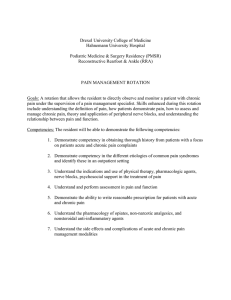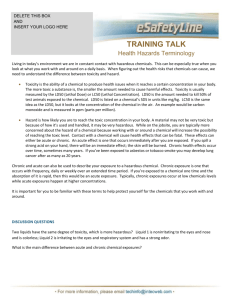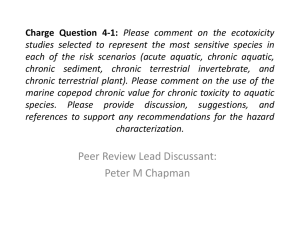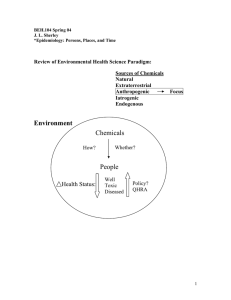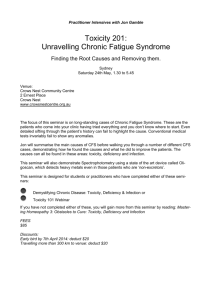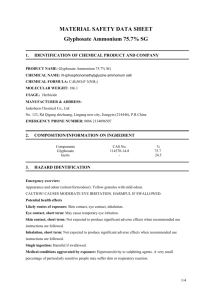Chapter 14: HAZARDOUS TO THE AQUATIC ENVIRONMENT
advertisement
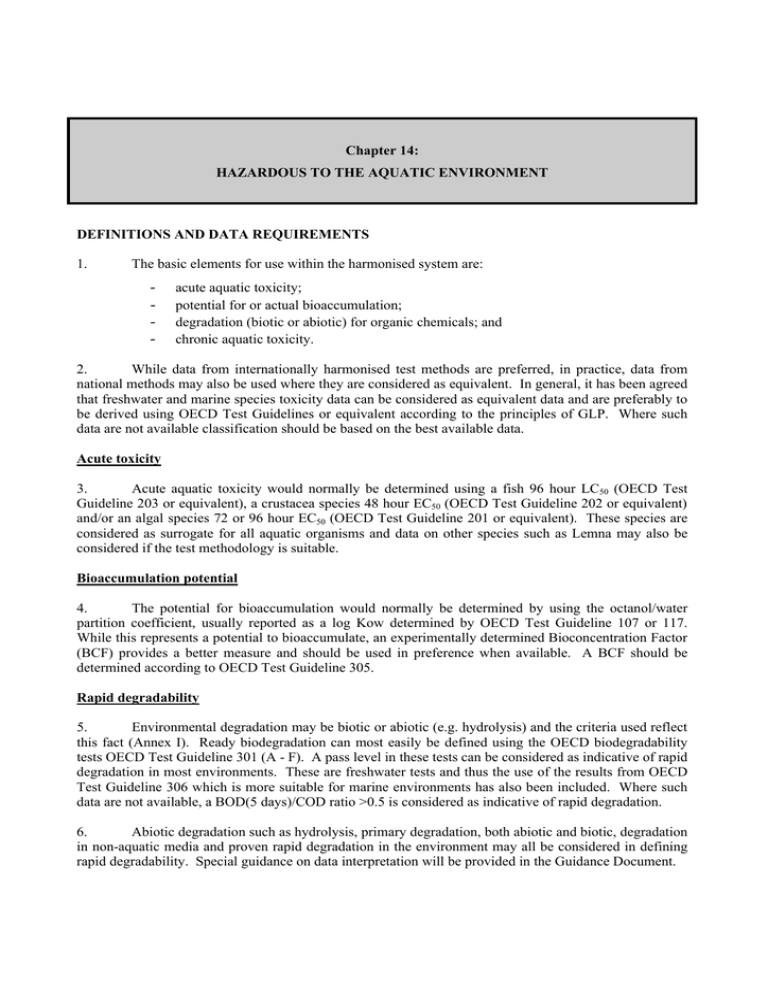
Chapter 14: HAZARDOUS TO THE AQUATIC ENVIRONMENT DEFINITIONS AND DATA REQUIREMENTS 1. The basic elements for use within the harmonised system are: - acute aquatic toxicity; potential for or actual bioaccumulation; degradation (biotic or abiotic) for organic chemicals; and chronic aquatic toxicity. 2. While data from internationally harmonised test methods are preferred, in practice, data from national methods may also be used where they are considered as equivalent. In general, it has been agreed that freshwater and marine species toxicity data can be considered as equivalent data and are preferably to be derived using OECD Test Guidelines or equivalent according to the principles of GLP. Where such data are not available classification should be based on the best available data. Acute toxicity 3. Acute aquatic toxicity would normally be determined using a fish 96 hour LC50 (OECD Test Guideline 203 or equivalent), a crustacea species 48 hour EC50 (OECD Test Guideline 202 or equivalent) and/or an algal species 72 or 96 hour EC50 (OECD Test Guideline 201 or equivalent). These species are considered as surrogate for all aquatic organisms and data on other species such as Lemna may also be considered if the test methodology is suitable. Bioaccumulation potential 4. The potential for bioaccumulation would normally be determined by using the octanol/water partition coefficient, usually reported as a log Kow determined by OECD Test Guideline 107 or 117. While this represents a potential to bioaccumulate, an experimentally determined Bioconcentration Factor (BCF) provides a better measure and should be used in preference when available. A BCF should be determined according to OECD Test Guideline 305. Rapid degradability 5. Environmental degradation may be biotic or abiotic (e.g. hydrolysis) and the criteria used reflect this fact (Annex I). Ready biodegradation can most easily be defined using the OECD biodegradability tests OECD Test Guideline 301 (A - F). A pass level in these tests can be considered as indicative of rapid degradation in most environments. These are freshwater tests and thus the use of the results from OECD Test Guideline 306 which is more suitable for marine environments has also been included. Where such data are not available, a BOD(5 days)/COD ratio >0.5 is considered as indicative of rapid degradation. 6. Abiotic degradation such as hydrolysis, primary degradation, both abiotic and biotic, degradation in non-aquatic media and proven rapid degradation in the environment may all be considered in defining rapid degradability. Special guidance on data interpretation will be provided in the Guidance Document. Chronic toxicity 7. Chronic toxicity data are less available than acute data and the range of testing procedures less standardised. Data generated according to the OECD Test Guidelines 210 (Fish Early Life Stage), or 211 (Daphnia Reproduction) and 201 (Algal Growth Inhibition) can be accepted. Other validated and internationally accepted tests could also be used. The NOECs or other equivalent L(E)Cx should be used. CONSIDERATIONS 8. The harmonised system for classifying chemical substances for the hazards they present to the aquatic environment is based on a consideration of systems existing at the time. The aquatic environment may be considered in terms of the aquatic organisms that live in the water, and the aquatic ecosystem of which they are part. To that extent, the proposal does not address aquatic pollutants for which there may be a need to consider effects beyond the aquatic environment such as the impacts on human health etc. The basis, therefore, of the identification of hazard is the aquatic toxicity of the substance, although this may be modified by further information on the degradation and bioaccumulation behaviour. 9. The proposed system is intended specifically for use with chemical substances and is not intended at this stage to cover preparations or other mixtures such as formulated pesticides. While the scheme is intended to apply to all substances, it is recognised that for some substances, e.g. metals, poorly soluble substances etc., special guidance will be necessary. 10. A Guidance Document has been prepared to cover issues such as data interpretation and the application of the criteria defined below to such groups of substances. Considering the complexity of this endpoint and the breadth of the application of the system, the Guidance Document is considered an important element in the operation of the harmonised scheme (see Annex 3). 11. Consideration has been given to existing classification systems as currently in use, including the EU Supply and Use Scheme, the revised GESAMP hazard evaluation procedure, IMO Scheme for Marine Pollutant, the European Road and Rail Transport Scheme (RID/ADR), the Canadian and US Pesticide systems and the US Land Transport Scheme. The harmonised scheme is considered suitable for use for packaged goods in both supply and use and multimodal transport schemes, and elements of it may be used for bulk land transport and bulk marine transport under MARPOL 73/78 Annex II insofar as this uses aquatic toxicity. 12. The harmonised classification system for substances consists of three acute classification categories and four chronic classification classes. The acute and the chronic classification categories are applied independently. The criteria for classification of a substance in acute categories I to III are defined on the basis of the acute toxicity data only (EC50 or LC50). The criteria for classification of a substance into chronic categories combine two types of information, i.e. acute toxicity data and environmental fate data (degradability and bioaccumulation data). For assignment of mixtures to chronic categories, degradation and bioaccumulation properties are derived from tests on components. CLASSIFICATION CRITERIA FOR SUBSTANCES 13. The harmonised classification system for substances consists of three acute classification categories and four chronic classification categories. The acute and the chronic classification categories are applied independently. The criteria for classification of a substance in acute categories I to III are 2 defined on the basis of the acute toxicity data only (EC50 or LC50). The criteria for classification of a substance into chronic categories combine two types of information, i.e. acute toxicity data and environmental fate data (degradability and bioaccumulation data). For assignment of mixtures to chronic categories, degradation and bioaccumulation properties are derived from tests on components. 14. Substances classified under the following criteria will be categorised as ‘hazardous to the aquatic environment’. These criteria describe in detail the classification categories. They are diagrammatically summarised in Table 1. Acute toxicity 96 hr LC50 (for fish) ≤1 mg/L and/or 48 hr EC50 (for crustacea) ≤1 mg/L and/or 72 or 96hr ErC50 (for algae or other aquatic plants) ≤1 mg/L. Category: Acute I may be subdivided for some regulatory systems to include a lower band at L(E)C50 ≤0.1 mg/L. Category: Acute II 96 hr LC50 (for fish) >1 - ≤10 mg/L and/or 48 hr EC50 (for crustacea) >1 - ≤10 mg/L and/or 72 or 96hr ErC50 (for algae or other aquatic plants) >1 - ≤10 mg/L. Category: Acute III 96 hr LC50 (for fish) >10 - ≤100 mg/L and/or 48 hr EC50 (for crustacea) >10 - ≤100 mg/L and/or 72 or 96hr ErC50 (for algae or other aquatic plants) >10 - ≤100 mg/L. Some regulatory systems may extend this range beyond an L(E)C50 of 100 mg/L through the introduction of another class. Category: Chronic I 96 hr LC50 (for fish) ≤1 mg/L and/or 48 hr EC50 (for crustacea) ≤1 mg/L and/or 72 or 96hr ErC50 (for algae or other aquatic plants) ≤1 mg/L and the substance is not rapidly degradable and/or the log Kow ≥ 4 (unless the experimentally determined BCF <500). Category: Chronic II 96 hr LC50 (for fish) >1 to ≤10 mg/L and/or 48 hr EC50 (for crustacea) >1 to ≤10 mg/L and/or 72 or 96hr ErC50 (for algae or other aquatic plants) >1 to ≤10 mg/L and the substance is not rapidly degradable and/or the log Kow ≥4 (unless the experimentally determined BCF <500), unless the chronic toxicity NOECs are > 1 mg/L. Category: Chronic III 96 hr LC50 (for fish) >10 to ≤100 mg/L and/or 48 hr EC50 (for crustacea) >10 to ≤100 mg/L and/or 72 or 96hr ErC50 (for algae or other aquatic plants) >10 to ≤100 mg/L and the substance is not rapidly degradable and/or the log Kow ≥4 (unless the experimentally determined BCF <500) unless the chronic toxicity NOECs are >1 mg/L. Category: Chronic IV Poorly soluble substances for which no acute toxicity is recorded at levels up to the water solubility, and which are not rapidly degradable and have a log Kow ≥ 4, indicating a potential to bioaccumulate, will be classified in this category unless other scientific evidence exists showing classification to be unnecessary. Such evidence would include an experimentally determined BCF <500, or a chronic toxicity NOECs >1 mg/L, or evidence of rapid degradation in the environment. Category: Acute I 3 Table 1: Classification Scheme for Substances Hazardous to the Aquatic Environment. Toxicity Acute (note 1) Box 1 value ≤ 1.00 Chronic (note 2) Degradability Bioaccumulation (note 3) (note 4) Acute Box 5 Box 6 Category: Acute I Box 1 Box 2 1.00 < value ≤ 10.0 Classification categories lack of rapid degradability BCF ≥ 500 or, if absent log Kow ≥ 4 Category: Acute II Box 2 Category: Acute III Box 3 Box 3 10.0 < value ≤ 100 Box 4 Box 7 No acute value > toxicity (note 5) 1.00 Chronic Category: Chronic I Boxes 1+5+6 Boxes 1+5 Boxes 1+6 Category: Chronic II Boxes 2+5+6 Boxes 2+5 Boxes 2+6 Unless Box 7 Category: Chronic III Boxes 3+5+6 Boxes 3+5 Boxes 3+6 Unless Box 7 Category: Chronic IV Boxes 4+5+6 Unless Box 7 Notes to Table 1: Note 1a. Acute toxicity band based on L(E)C-50 values in mg/L for fish, crustacea and/or algae or other aquatic plants (or QSAR estimation if no experimental data). Note 1b. Where the algal toxicity ErC-50 [ = EC-50 (growth rate)] falls more than 100 times below the next most sensitive species and results in a classification based solely on this effect, consideration should be given to whether this toxicity is representative of the toxicity to aquatic plants. Where it can be shown that this is not the case, professional judgement should be used in deciding if classification should be applied. Classification should be based on the ErC-50. In circumstances where the basis of the EC-50 is not specified and no ErC-50 is recorded, classification should be based on the lowest EC-50 available. Note 2a. Chronic toxicity band based on NOEC values in mg/L for fish or crustacea or other recognised measures for long-term toxicity. Note 2b. It is the intention that the system be further developed to include chronic toxicity data. Note 3. Lack of rapid degradability is based on either a lack of Ready Biodegradability or other evidence of lack of rapid degradation. Note 4. Potential to bioaccumulate, based on an experimentally derived BCF ≥ 500 or, if absent, a log Kow ≥ 4 provided log Kow is an appropriate descriptor for the bioaccumulation potential of the substance. Measured log Kow values take precedence over estimated values and measured BCF values take precedence over log Kow values. Note 5. “No acute toxicity” is taken to mean that the L(E)C-50 is above the water solubility. Also for poorly soluble substances, (w.s. < 1.00 mg/L), where there is evidence that the acute test would not have provided a true measure of the intrinsic toxicity. 4 Rationale 15. The system for classification recognises that the core intrinsic hazard to aquatic organisms is represented by both the acute and chronic toxicity of a substance, the relative importance of which is determined by the specific regulatory system in operation. Distinction can be made between the acute hazard and the chronic hazard and therefore separate hazard categories are defined for both properties representing a gradation in the level of hazard identified. The lowest of the available toxicity values will normally be used to define the appropriate hazard class(es). There may be circumstances, however, when a weight of evidence approach may be used. Acute toxicity data are the most readily available and the tests used are the most standardised. For that reason, these data form the core of the classification system. 16. Acute toxicity represents a key property in defining the hazard where transport of large quantities of a substance may give rise to short-term dangers arising from accidents or major spillages. Hazards categories up to L(E)C50 values of 100 mg/L are thus defined although categories up to 1000 mg/L may be used in certain regulatory frameworks. The Acute Category I may be further sub-divided to include an additional category for acute toxicity L(E)C50 ≤0.1 mg/L in certain regulatory systems such as that defined by MARPOL 73/78 Annex II. It is anticipated that their use would be restricted to regulatory systems concerning bulk transport. 17. For packaged substances it is considered that the principal hazard is defined by chronic toxicity, although acute toxicity at L(E)C50 levels ≤1 mg/L are also considered hazardous. Levels of substances up to 1 mg/L are considered as possible in the aquatic environment following normal use and disposal. At toxicity levels above this, it is considered that the short-term toxicity itself does not describe the principle hazard, which arises from low concentrations causing effects over a longer time scale. Thus, a number of hazard categories are defined which are based on levels of chronic aquatic toxicity. Chronic toxicity data are not available for many substances, however, and it is necessary to use the available data on acute toxicity to estimate this property. The intrinsic properties of a lack of rapid degradability and/or a potential to bioconcentrate in combination with acute toxicity may be used to assign a substance to a chronic hazard category. Where chronic toxicity is available showing NOECs >1 mg/L, this would indicate that no classification in a chronic hazard category would be necessary. Equally, for substances with an L(E)C50 >100 mg/L, the toxicity is considered as insufficient to warrant classification in most regulatory systems. 18. While the current system will continue to rely on the use of acute toxicity data in combination with a lack of rapid degradation and/or a potential to bioaccumulate as the basis for classification for assigning a chronic hazard category, it is recognised that actual chronic toxicity data would form a better basis for classification where these data are available. It is thus the intention that the scheme should be further developed to accommodate such data. It is anticipated that in such a further development, the available chronic toxicity data would be used to classify in the chronic hazard in preference to that derived from their acute toxicity in combination with a lack of rapid degradation and/or a potential to bioaccumulate. 19. Recognition is given to the classification goals of MARPOL 73/78 Annex II which covers the transport of bulk quantities in ships tanks, which are aimed at regulating operational discharges from ships and assigning of suitable ship types. They go beyond that of protecting aquatic ecosystems, although that clearly is included. Additional hazard categories may thus be used which take account of factors such as physico-chemical properties and mammalian toxicity. 5 CLASSIFICATION CRITERIA FOR MIXTURES 20. The classification system for mixtures covers all classification categories which are used for substances meaning acute categories I to III and chronic categories I to IV. In order to make use of all available data for purposes of classifying the aquatic environmental hazards of the mixture, the following assumption has been made and is applied where appropriate. The “relevant components” of a mixture are those which are present in a concentration of 1% (w/w) or greater, unless there is a presumption (e.g. in the case of highly toxic components) that a component present at less than 1% can still be relevant for classifying the mixture for aquatic environmental hazards. 21. The approach for classification of aquatic environmental hazards is tiered, and is dependent upon the type of information available for the mixture itself and for its components. Elements of the tiered approach include: i) classification based on tested mixtures; ii) classification based on bridging principles, iii) the use of an "additivity formula" and /or "summation of classifed components". Figure 1 outlines the process to be followed. 6 Figure 1: Tiered Approach to Classification of Mixtures for Acute and Chronic Aquatic Environmental Hazards Aquatic toxicity test data available on the mixture as a whole No Sufficient data available on similar mixtures to estimate hazards Yes Yes Apply bridging principles (paragraphs 24-31) CLASSIFY for acute/chronic toxicity (paragraph 23) CLASSIFY For acute/chronic toxicity No Either aquatic toxicity or classification data available for all relevant components Yes Apply Summation Method (para 35-47) using: • Percentage of all components classified as “Chronic” • Percentage of components classified as “Acute” • Percentage of components with acute toxicity data: apply Additivity Formula (paragraph 33) and convert the derived L(E)C50 to the appropriate “Acute” Category CLASSIFY For acute/chronic toxicity No Use available hazard data of known components Apply Summation Method and Additivity Formula (paragraphs 31-47) and apply paragraph 48 CLASSIFY For acute /chronic toxicity Classification of Mixtures When Data are Available for the Complete Mixture. 22. When the mixture as a whole has been tested to determine its aquatic toxicity, it can be classified according to the criteria that have been agreed for substances, but only for acute toxicity. The classification should be based on the data for the most sensitive taxon: fish, crustacea and/or algae/plants. Classification of mixtures by using LC50 or EC50 data for the mixture as a whole is not possible for chronic categories since both toxicity data and environmental fate data are needed, and there are no degradability and bioaccumulation data for mixtures as a whole. It is not possible to apply the criteria for chronic classification because the data from degradability and bio-accumulation tests of mixtures cannot be interpreted; they are meaningful only for single substances. 7 23. When there is acute toxicity test data (LC50 or EC50) available for the mixture as a whole, this data as well as information with respect to the classification of components for chronic toxicity should be used to complete the classification for tested mixtures as follows. When chronic (long term) toxicity data (NOEC) is also available, this should be used as well. • L(E)C50 (LC50 or EC50) of the tested mixture ≤ 100mg/L and NOEC of the tested mixture ≤ 1.0 mg/L or unknown: → Classify mixture as Category Acute I, II or III → Apply Summation of Classified Components approach (see paragraphs 42-46) for chronic classification (Chronic I, II, III, IV or no need of chronic classification). • L(E)C50 of the tested mixture ≤ 100mg/L and NOEC of the tested mixture > 1.0 mg/L: → Classify mixture as Category Acute I, II or III → Apply Summation of Classified Components approach (see paragraphs 42-46) for classification as Category Chronic I. If the mixture is not classified as Category Chronic I, then there is no need for chronic classification. • L(E)C50 of the tested mixture >100mg/L, or above the water solubility, and NOEC of the tested mixture ≤ 1.0mg/L or unknown: → No need to classify for acute toxicity → Apply Summation of Classified Components approach (see paragraphs 42-46) for Chronic classification (Category Chronic IV or no need for chronic classification). • L(E)C50 of the tested mixture >100mg/L, or above the water solubility, and NOEC of the tested mixture > 1.0 mg/L: → No need to classify for acute or chronic toxicity Classification of Mixtures When Data are not Available for the Complete Mixture. Bridging Principles 24. Where the mixture itself has not been tested to determine its aquatic environmental hazard, but there are sufficient data on the individual components and similar tested mixtures to adequately characterise the hazards of the mixture, this data will be used in accordance with the following agreed bridging rules. This ensures that the classification process uses the available data to the greatest extent possible in characterising the hazards of the mixture without the necessity for additional testing in animals. Dilution 25. If a mixture is formed by diluting another classified mixture or a substance with a diluent which has an equivalent or lower aquatic hazard classification than the least toxic original component and which is not expected to affect the aquatic hazards of other components, then the mixture may be classified as equivalent to the original mixture or substance. 26. If a mixture is formed by diluting another classified mixture or a substance with water or other totally non-toxic material, the toxicity of the mixture can be calculated from the original mixture or substance. 8 Batching 27. The aquatic hazard classification of one production batch of a complex mixture can be assumed to be substantially equivalent to that of another production batch of the same commercial product and produced by or under the control of the same manufacturer, unless there is reason to believe there is significant variation such that the aquatic hazard classification of the batch has changed. If the latter occurs, new classification is necessary. Concentration of Mixtures which are classified with the most severe classification categories (Chronic I and Acute I) 28. If a mixture is classified as Chronic I and/or Acute I, and components of the mixture which are classified as Chronic I and/or Acute I are further concentrated, the more concentrated mixture should be classified with the same classification category as the original mixture without additional testing. Interpolation within One Toxicity Category 29. If mixtures A and B are in the same classification category and mixture C is made in which the toxicologically active components have concentrations intermediate to those in mixtures A and B, then mixture C is assumed to be in the same category as A and B. Note that the identity of the components is the same in all three mixtures. Substantially Similar Mixtures 30. Given the following: a). b). c). d). Two mixtures: i.) A + B ii.) C + B The concentration of component B is the same in both mixtures. The concentration of component A in mixture (i) equals that of component C in mixture (ii). Classification for A and C are available and are the same, i.e. they are in the same hazard category and are not expected to affect the aquatic toxicity of B. 31. Then there is no need to test mixture (ii) if mixture (i) is already characterised by testing and both mixtures would be classified in the same category. 9 Classification of Mixtures When Data are Available for All Components or Only for Some Components of the Mixture. 32. The classification of a mixture is based on summation of the classification of its components. Details of the summation method are described in paragraphs 35-47. 33. In practice, mixtures are often made of a combination of both components that are classified (as Acute I, II, III and/or Chronic I, II, III, IV) and those for which adequate test data is available. The percentage of components classified as “Acute” or “Chronic” will feed straight in to the summation method (see below). When adequate toxicity data is available for more than one component in the mixture, the combined toxicity of those components may be calculated using the following additivity formula, and the calculated toxicity may be used to assign that portion of the mixture an acute toxicity category which is then subsequently used in applying the summation method. ∑ Ci L ( E )C 50 m =∑ η Ci L ( E )C 50 i where: Ci L(E)C50i η = concentration of component i (weight percentage) = (mg/L) LC50 or EC50 for component i = number of components L(E)Cm = L(E)-C50 of the part of the mixture with test data 34. When applying the additivity formula for part of the mixture, it is preferable to calculate the toxicity of this part of the mixture using for each substance toxicity values that relate to the same species (i.e.; fish, daphnia or algae) and then to use the highest toxicity (lowest value) obtained (viz., use the most sensitive of the three species). However, when toxicity data for each component are not available in the same species, the toxicity value of each component should be selected in the same manner that toxicity values are selected for the classification of substances, i.e. the higher toxicity (from the most sensitive test organism) is used. The calculated acute toxicity may then be used to classify this part of the mixture as Acute I, II or III using the same criteria described for substances. Summation Method Rationale 35. In case of the substance classification categories Acute I/Chronic I to Acute III/Chronic III, the underlying toxicity criteria differ by a factor of 10 in moving from one category to another. Substances with a classification in a high toxicity band may therefore contribute to the classification of a mixture in a lower band. The calculation of these classification categories therefore needs to consider the contribution of all substances classified Acute I/Chronic I to Acute III/Chronic III together. 36. When a mixture contains components classified as Acute Category I, attention should be paid to the fact that such components, when their acute toxicity is well below 1 mg/L (See also paragraph 314), contribute to the toxicity of the mixture even at a low concentration. Active ingredients in pesticides often possess such high aquatic toxicity but also some other substances like organometallic compounds. Under these circumstances the application of the normal cut-off values/concentration limits may lead to an “underclassification” of the mixture. Therefore, multiplying factors should be applied to account for highly toxic components, as described in paragraph 47. 10 Classification Procedure 37. In general a more severe classification for mixtures overrides a less severe classification, e.g. a classification with Chronic I overrides a classification with Chronic II. As a consequence the classification procedure is already completed if the results of the classification is Chronic I. A more severe classification than chronic I is not possible therefore it is not necessary to undergo the further classification procedure. Classification for the Acute Categories I, II and III 38. First all components classified as Acute I are considered. If the sum of these components is greater than 25% the whole mixture is classified as Category Acute I. If the result of the calculation is a classification of the mixture as Category Acute I, the classification process is completed. 39. In cases where the mixture is not classified as Acute I, classification of the mixture as Acute II is considered. A mixture is classified as Acute II if ten times the sum of all components classified as Acute I plus the sum of all components classified as Acute II is greater than 25%. If the result of the calculation is classification of the mixture as Category Acute II, the classification process is completed. 40. In cases where the mixture is not classified either as Acute I or Acute II, classification of the mixture as Acute III is considered. A mixture is classified as Acute III if 100 times the sum of all components classified as Acute I plus 10 times the sum of all components classified as Acute II plus the sum of all components classified as Acute III is greater than 25%. 41. The classification of mixtures for acute hazards based on this summation of classified components, is summarised in Table 2 below. Table 2: Classification of a mixture for acute hazards, based on summation of classified components. Sum of components classified as: Mixture is classified as: Acute I x M1) (M x 10 x Acute I) +Acute II (M x 100 x Acute I)+ (10 x Acute II) + Acute III >25% >25% >25% Acute I Acute II Acute III 1) for explanation of the M factor, see paragraph 47 Classification for the Chronic Categories I, II, III and IV 42. First all components classified as Chronic I are considered. If the sum of these components is greater than 25% the mixture is classified as Category Chronic I. If the result of the calculation is a classification of the mixture as Category Chronic I the classification procedure is completed. 43. In cases where the mixture is not classified as Chronic I, classification of the mixture as Chronic II is considered. A mixture is classified as Chronic II if 10 times the sum of all components classified as Chronic I plus the sum of all components classified as Chronic II is greater than 25%. If the result of the calculation is classification of the mixture as Chronic II, the classification process is completed. 44. In cases where the mixture is not classified either as Chronic I or Chronic II, classification of the mixture as Chronic III is considered. A mixture is classified as Chronic III if 100 times the sum of all components classified as Chronic I plus 10 times the sum of all components classified with Chronic II plus the sum of all components classified as Chronic III is greater than 25%. 11 45. If the mixture is still not classified in either Category Chronic I, II or III, classification of the mixture as Chronic IV should be considered. A mixture is classified as Chronic IV if the sum of the percentages of components classified as Chronic I, II, III and IV is greater than 25%. 46. The classification of mixtures for chronic hazards, based on this summation of classified components, is summarised in Table 3 below. Table 3: Classification of a mixture for chronic hazards, based on summation of classified components. Sum of components classified as: Mixture is classified as: Chronic I x M1) (M x 10 x Chronic I)+Chronic II (M x 100 x Chronic I)+(10x Chronic II)+Chronic III Chronic I + Chronic II + Chronic III +Chronic IV >25% >25% >25% > 25% Chronic I Chronic II Chronic III Chronic IV 1) for explanation of the M factor, see paragraph 47 Mixtures with highly toxic components 47. Acute Category 1 components with toxicities well below 1 mg/L may influence the toxicity of the mixture and should be given increased weight in applying the summation of classification approach. When a mixture contains components classified as Acute or Chronic Category I, the tiered approach described in paragraphs 38-46 should be applied using a weighted sum by multiplying the concentrations of Acute Category 1 components by a factor, instead of merely adding up the percentages. This means that the concentration of “Acute I” in the left column of Table 2 and the concentration of “Chronic I” in the left column of Table 3 are multiplied by the appropriate multiplying factor. The multiplying factors to be applied to these components are defined using the toxicity value, as summarised in Table 4 below. Therefore, in order to classify a mixture containing Acute/Chronic I components, the classifier needs to be informed of the value of the M factor in order to apply the summation method. Alternatively, the additivity formula (paragraph 33) may be used when toxicity data are available for all highly toxic components in the mixture and there is convincing evidence that all other components, including those for which specific acute toxicity data are not available, are of low or no toxicity and do not significantly contribute to the environmental hazard of the mixture. Table 4: Multiplying factors for highly toxic components of mixtures L(E)C50 value 0.1 < L(E)C50 1 0.01 < L(E)C50 ≤ 0.1 0.001 < L(E)C50 ≤ 0.01 0.0001 < L(E)C50 ≤ 0.001 0.00001 < L(E)C50 ≤ 0.0001 (continue in factor 10 intervals) Multiplying factor (M) 1 10 100 1000 10000 12 Classification of Mixtures With Components Without Any Useable Information 48. In the event that no useable information on acute and/or chronic aquatic toxicity is available for one or more relevant components, it is concluded that the mixture cannot be attributed (a) definitive hazard category(ies). In this situation the mixture should be classified based on the known components only, with the additional statement that: “x percent of the mixture consists of components(s) of unknown hazards to the aquatic environment”. HAZARD COMMUNICATION Allocation of Label Elements 49. General and specific considerations concerning labelling requirements are provided in Chapter 4. Annex 5 contains examples of precautionary statements and pictograms which can be used where allowed by the competent authority. Additional reference sources providing advice on the use of precautionary information is also included. Table 5: Label Elements for Hazardous to the Aquatic Environment Category 1 Symbol Fish and Tree Signal Word Warning Hazard Statement Very toxic aquatic life Category 1 Symbol Fish and Tree Signal Word Warning Hazard Statement Acute Category 2 Category 3 No symbol is used No symbol is used No signal word is used to Toxic to aquatic life Chronic Category 2 Fish and Tree No signal word is used Very toxic to Toxic to aquatic aquatic life with life with long long lasting effects lasting effects 13 No signal word is used Harmful to aquatic life Category 3 Category 4 No symbol is used No symbol is used No signal word is used Harmful to aquatic life with long lasting effects No signal word is used May cause long lasting harmful effects to aquatic life DECISION LOGIC AND GUIDANCE Decision Logic Guidance 50. The organisms fish, crustacea and algae are tested as surrogate species covering a range of trophic levels and taxa, and the test methods are highly standardised. Data on other organisms may also be considered, however, provided they represent equivalent species and test endpoints. The algal growth inhibition test is a chronic test but the EC50 is treated as an acute value for classification purposes. This EC50 should normally be based on growth rate inhibition. If only the EC50 based on reduction in biomass is available, or it is not indicated which EC50 is reported, this value may be used in the same way. 51. Aquatic toxicity testing by its nature, involves the dissolution of the substance under test in the water media used and the maintenance of a stable bioavailable exposure concentration over the course of the test. Some substances are difficult to test under standard procedures and thus special guidance will be developed on data interpretation for these substances and how the data should be used when applying the classification criteria. 52. It is the bioaccumulation of substances within the aquatic organisms that can give rise to toxic effects over longer time scales even when actual water concentrations are low. The potential to bioaccumulate is determined by the partitioning between n-octanol and water. The relationship between the partition coefficient of an organic substance and its bioconcentration as measured by the BCF in fish has considerable scientific literature support. Using a cut-off value of log P(o/w) ≥ 4 is intended to identify only those substances with a real potential to bioconcentrate. In recognition that the log P(o/w) is only an imperfect surrogate for a measured BCF, such a measured value would always take precedence. A BCF in fish of <500 is considered as indicative of a low level of bioconcentration. 53. Substances that rapidly degrade can be quickly removed from the environment. While effects can occur, particularly in the event of a spillage or accident, they will be localised and of short duration. The absence of rapid degradation in the environment can mean that a substance in the water has the potential to exert toxicity over a wide temporal and spatial scale. One way of demonstrating rapid degradation utilises the biodegradation screening tests designed to determine whether a substance is `readily biodegradable'. Thus a substance which passes this screening test is one that is likely to biodegrade `rapidly' in the aquatic environment, and is thus unlikely to be persistent. However, a fail in the screening test does not necessarily mean that the substance will not degrade rapidly in the environment. Thus a further criterion was added which would allow the use of data to show that the substance did actually degrade biotically or abiotically in the aquatic environment by >70% in 28 days. Thus, if degradation could be demonstrated under environmentally realistic conditions, then the definition of `rapid degradability' would have been met. Many degradation data are available in the form of degradation halflives and these can also be used in defining rapid degradation. Details regarding the interpretation of these data will be further elaborated in the Guidance Document. Some tests measure the ultimate biodegradation of the substance, i.e. full mineralisation is achieved. Primary biodegradation would not normally qualify in the assessment of rapid degradability unless it can be demonstrated that the degradation products do not fulfill the criteria for classification as hazardous to the aquatic environment. 54. It must be recognised that environmental degradation may be biotic or abiotic (e.g. hydrolysis) and the criteria used reflect this fact. Equally, it must be recognised that failing the ready biodegradability criteria in the OECD tests does not mean that the substance will not be degraded rapidly in the real environment. Thus where such rapid degradation can be shown, the substance should be considered as rapidly degradable. Hydrolysis can be considered if the hydrolysis products do not fulfil the criteria for 14 classification as hazardous to the aquatic environment. A specific definition of rapid degradability is shown below. Other evidence of rapid degradation in the environment may also be considered and may be of particular importance where the substances are inhibitory to microbial activity at the concentration levels used in standard testing. The range of available data and guidance on its interpretation will be provided in the Guidance Document. RAPID DEGRADABILITY Substances are considered rapidly degradable in the environment if the following criteria hold true: a) if in 28-day ready biodegradation studies, the following levels of degradation are achieved; tests based on dissolved organic carbon: 70% tests based on oxygen depletion or carbon dioxide generation: 60% of theoretical maxima These levels of biodegradation must be achieved within 10 days of the start of degradation which point is taken as the time when 10% of the substance has been degraded. or b) if, in those cases where only BOD and COD data are available, when the ratio of BOD5/COD is ≥0.5 or c) if other convincing scientific evidence is available to demonstrate that the substance can be degraded (biotically and/or abiotically) in the aquatic environment to a level >70% within a 28 day period. 55. For inorganic compounds and metals, the concept of degradability as applied to organic compounds has limited or no meaning. Rather the substance may be transformed by normal environmental processes to either increase or decrease the bioavailability of the toxic species. Equally the use of bioaccumulation data should be treated with care. Specific guidance will be provided on how these data for such materials may be used in meeting the requirements of the classification criteria. 56. Poorly soluble inorganic compounds and metals may be acutely or chronically toxic in the aquatic environment depending on the intrinsic toxicity of the bioavailable inorganic species and the rate and amount of this species which may enter solution. A protocol for testing these poorly soluble materials is being developed and will be covered further in the special guidance. 57. The system also introduces as `safety net' classification (Category: Chronic IV) for use when the data available does not allow classification under the formal criteria but there are nevertheless some grounds for concern. The precise criteria are not defined with one exception. For poorly water soluble organic substances for which no toxicity has been demonstrated, classification can occur if the substance is both not rapidly degraded and has a potential to bioaccumulate. It is considered that for such poorly 15 soluble substances, the toxicity may not have been adequately assessed in the short-term test due to the low exposure levels and potentially slow uptake into the organism. The need for this classification can be negated by demonstrating the absence of long-term effects, i.e. a long-term NOECs > water solubility or 1 mg/L, or rapid degradation in the environment. 58. While experimentally derived test data are preferred, where no experimental data are available, validated Quantitative Structure Activity Relationships (QSARs) for aquatic toxicity and log Kow may be used in the classification process. Such validated QSARs may be used without modification to the agreed criteria, if restricted to chemicals for which their mode of action and applicability are well characterised. Validity may be judged according to the criteria established within the USEPA/EU/Japan Collaborative Project. Reliable calculated toxicity and log Kow values should be valuable in the safety net context. QSARs for predicting ready biodegradation are not yet sufficiently accurate to predict rapid degradation. SUMMARY TABLE EXAMPLES 16
